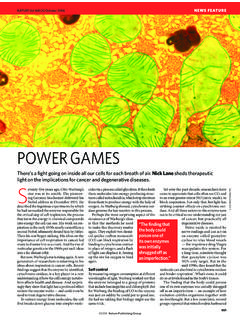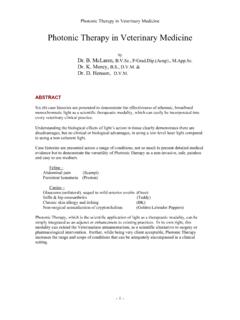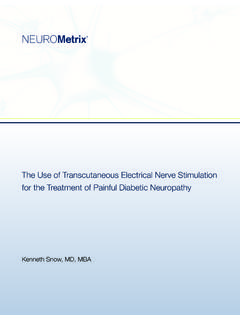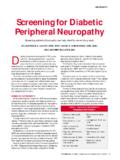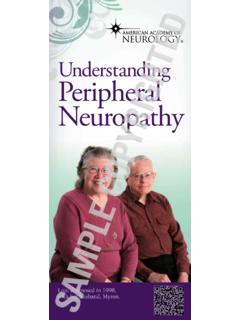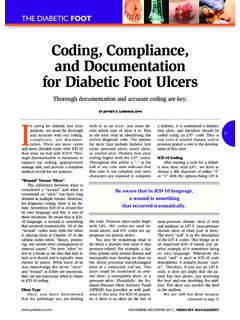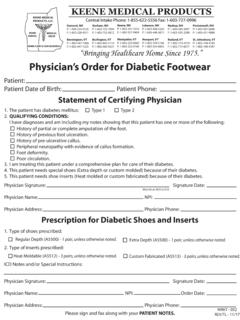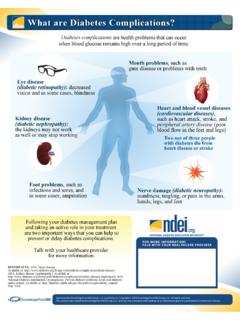Transcription of Symptomatic reversal of peripheral neuropathy in …
1 Symptomatic reversal of peripheral neuropathy in diabetic patients Symptomatic reversal of peripheral neuropathy in diabetic patients Alan B. Kochman. PT 1 Dale Carnegie. DPM. 2 and Thomas J. Burke. PhD 3 1 The Medical Center of Aurora. Aurora. CO. 2 Department of Orthopedics, Denver Health Medical Center, Denver. CO. 3 Integrated Systems Physiology, Inc., Aurora. CO Running head: reversal of peripheral neuropathy Word count 3264: Correspondence and page charges: Thomas J. Burke. Integrated Systems Physiology. Inc. Abstract: Objective: There is no therapy which reverses peripheral neuropathy (PN) in most diabetic patients . We hypothesized that a FDA cleared medical device, which emits monochromatic near infrared (890 nm) photo energy (MIRE) would improve neural function lost during diabetes. Research Design arid Methods: 49 consecutive diabetic subjects (Type 1. n=25: Type II, n=24).
2 With established neuropathy received MIRE treatment to determine if there was an improvement of sensation. All had PN classified as either absent. diminished, or impaired protective sensation assessed by the Semmes-Weinstein (SW) monofilament test or hot/cold (H/C) sensation impairment. Impaired protective sensation, ( or above) was present in 100% of subjects (range: ) and 42 of 49 subjects had SW values exceeding reported to be one of the most sensitive predictors of eventual diabetic foot ulceration. H/C sensation was absent (54%) or impaired (46%) prior to initiating treatment. The MIRE diode array was placed in contact with the skin on the lower leg/foot for 30 , 3X/week for one month. SW and H/C tests were repeated at two and four weeks. Results: After 6 treatments, most subjects exhibited improved sensation. After 12 treatments, no subject continued to experience absent sensation to HC: all had improved sensation based on SW.
3 - 1 - Symptomatic reversal of peripheral neuropathy in diabetic patients Remarkably. 65% of subjects exhibited restoration of protective sensation ( or below) and no subject had a SW value above Conclusions: MIRE may be a very safe, drug free, non-invasive treatment for the consistent and predictable improvement of sensation in diabetic subjects with PN of the feet. Introduction: diabetic peripheral neuropathy is a consequence of diabetes-mediated impairment in blood flow to. and resultant hypoxia of. nerves (1). There is no treatment for reversing the neurologic deficit of this disease manifestation although some treatments, such as capsaicin cream, tricyclic antidepressants and valproic acid are efficacious in diminishing pain (2). Other studies have demonstrated some increase in conduction with use of aldose reductase inhibitors and insulin pumps or pancreas transplantation (3).
4 With each of these approaches there have been notable problems in feasibility, logistics, and efficacy so that additional research into preventing/treating diabetic neuropathy has become a major research focus of the Juvenile Diabetes Foundation and the National Institutes of Health. Impaired sensation in the feet becomes evident to the patient and clinician several years after the onset of diabetes (4) and, importantly, does not spontaneously regress: in other words, diabetic peripheral neuropathy is considered to be a progressive disease. Ultimately the loss of feeling can result in one or more ulcerations of the foot or feet. If the degree of sensory impairment reaches a level of , using the Semmes-Weinstein monofilament test, there is a very high likelihood of ulceration, followed by amputation (5). Thus, other approaches to improving blood flow in the feet of diabetic patients could be advantageous in the restoration of sensation: restoration of adequate circulation might delay the onset of ulcerations that often lead to amputations.
5 We have treated many diabetic and other subjects with MIRE in a protocol designed to heal otherwise recalcitrant ulcers, including venous stasis and diabetic ulcers, on the lower leg (6). The device is - 2 - Symptomatic reversal of peripheral neuropathy in diabetic patients FDA cleared for increasing circulation and reducing, pain. In many instances, subjects reported feeling a sensation of warmth, several days after beginning treatment, although they had not been able to discern differences in temperature prior to MIRE treatment. To investigate if, indeed, sensation was returning to the lower, we performed a prospective study in diabetic subjects with neuropathy . The results demonstrate that all 49 subjects had partial restoration of feeling in their feet at the end of the 30-day trial. To our knowledge this is the first, highly successful, non-invasive drug free maneuver, which restores, at least temporarily, neural sensation in diabetic subjects.
6 Methods and Materials: All subjects were treated at The Medical Center of Aurora, a Healthone facility, Aurora, CO in the Physical Therapy Department. The subjects ranged in age from 35 to 80 years old; 25 were Type I diabetic patients and 24 were Type IT diabetic patients . All had peripheral neuropathy based on the Semmes-Weinstein (SW) monofilament test. In addition the ability to detect hot vs. cold was also absent or impaired in each patient. No novel treatments or pharmaceuticals that would have uniquely modified circulation in the lower extremities were employed during the 30 days prior to beginning this study. No changes were made in the standard of medical care associated with diabetes for these subjects, including insulin or oral hypoglycemic agents, diet, blood pressure medications, and exercise. The SW test is often used as an adjunct to gait testing analysis in a PT department.
7 Such information guides the therapist in his or her efforts to reeducate the muscles of the lower leg (7). The study was initiated in diabetic subject 1 in December 1999 and we treated the next 48 diabetic subjects whose SW. H/C, and gait analysis values were abnormal. Procedure: MIRE is delivered from a series of 60 GaAlAs diodes in a flexible pad (diode array) placed on the feet and/or lower leg. Four diode arrays (60 diodes in each pad) were used during the treatment. Each - 3 - Symptomatic reversal of peripheral neuropathy in diabetic patients application was for 30 minutes. One diode array was placed on the distal posterior aspect of the tibia in an effort to altercirculation the posterior tibial artery and another diode array was placed over the anterior distal tibia in an effort to affect the dorsalis pedis artery. On array was placed on the dorsal and another on the ventral surface of the foot This was done to each foot.
8 An alternate pad placement was used specifically at the plantar aspect of each foot if the posterior tibia region was uncomfortable for some subjects. Several sizes of SW monofilaments were applied to at least three areas of the plantar side of the feet. As far as possible, the same locations were tested at each visit. The filament was applied until it began to bend, it was held in place for approximately seconds. Each site was tested three times. Care was taken to test areas that had the least thickness of the keratin layer. The test sites were the great toe, plantar arch region, and the fourth toe. The response to the filament testing was based on the subjective response from the patient of NO W when the patient could feel the filament. Hot/cold testing was also done at the same test sites. Response to the hot/cold testing was determined from subjective reports of whether the patient could sense the hot or cold bar.
9 These were graded as absent, impaired, or intact. Statistics: The data for Type I and Type II diabetic patients were grouped and analyzed by repeated measures analysis; values reported are means SD. Significance was accepted as P< Results: The ages of subjects, Type of diabetes (I or II), SW values, and hot/cold (H/C) detection ability prior to beginning the study and after MIRE treatment are shown in Table 1. Type I diabetic patients ( yo) were approximately 12 years younger than the Type II diabetic subjects ( yo). - 4 - Symptomatic reversal of peripheral neuropathy in diabetic patients Baseline SW deficits were virtually identical in the Type I (mean SD: ) and Type II ( ) (Table 1; Figures 1 and 2L Thirteen Type I diabetic subjects and 13 Type II diabetic subjects had absent sensation to H/C prior to treatment (Table I). Eighty-eight percent of the Type I subjects exhibited diminished or protective sensation using the SW test ( ) after 12 MIRE treatments (Table I and Figure 1).)
10 Figure 2 documents a similar response to MIRE treatment in Type II diabetic subjects. Specifically, after 12 treatments with MIRE 62% of the Type II subjects had diminished or protective sensation ( ) where none had this ability prior to treatment ( ). The mean ( SD) SW values before and after 12 treatments with MIRE for all diabetic subjects are shown in Figure 3, Whereas 42/49 subjects had values above prior to initiating the study. by week 4 (12 treatments) all subjects had improved sensation as assessed by the SW test and no patient had a value above After 12 treatments with MIRE nine of twelve Type I subjects converted from impaired H/C sensation to an intact ability to discriminate hot from cold (Table 1). Four of eleven Type II diabetic patients were now able to discriminate hot vs. cold after 12 treatments with the MIRE (Table 1). Discussion: Several products expected to improve the neurologic deficit of diabetic neuropathy , including nerve growth factor and aldose reductase inhibitors have failed, in large clinical trials, to meet full expectations of clinicians or patients (8,9).
